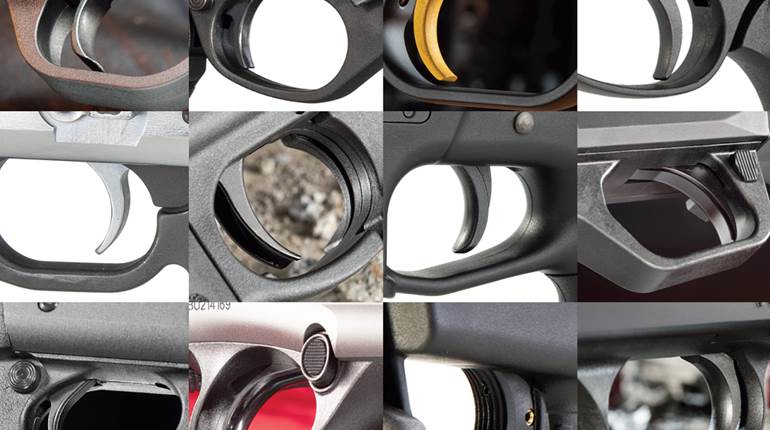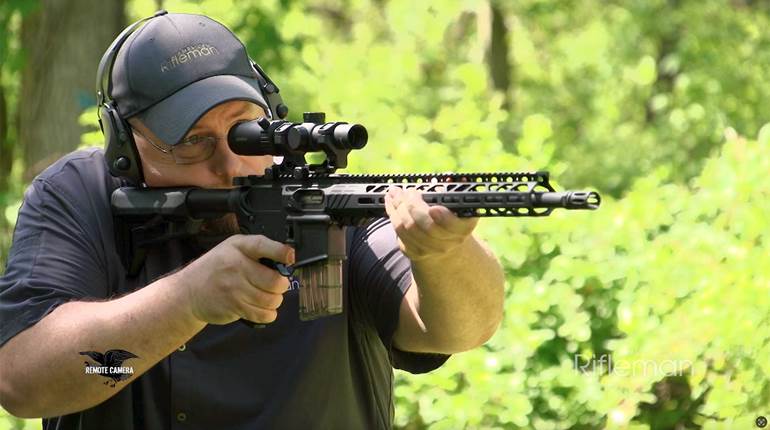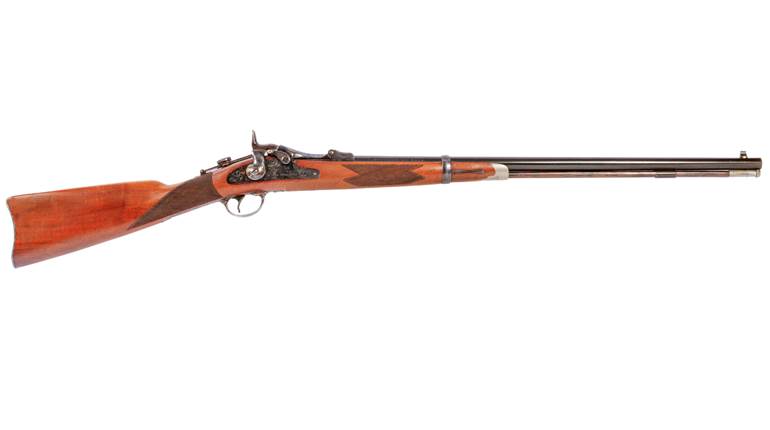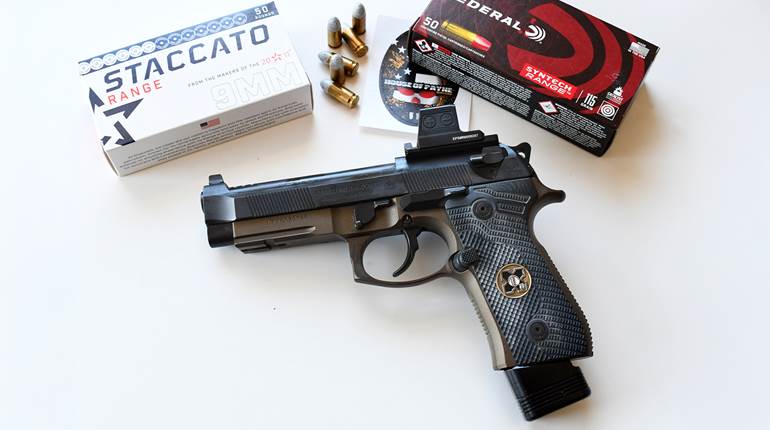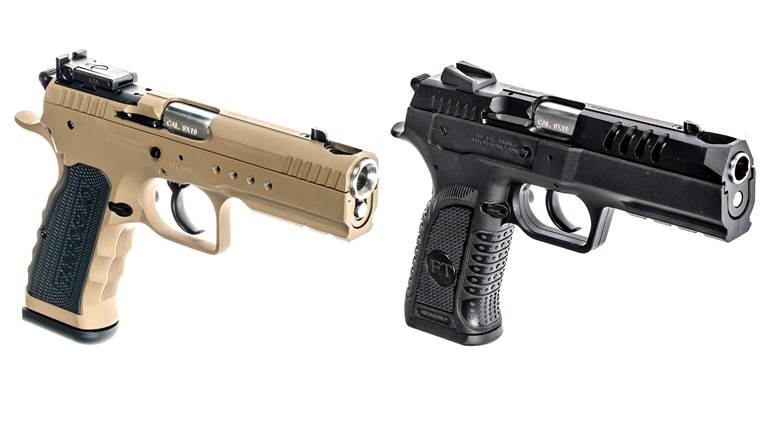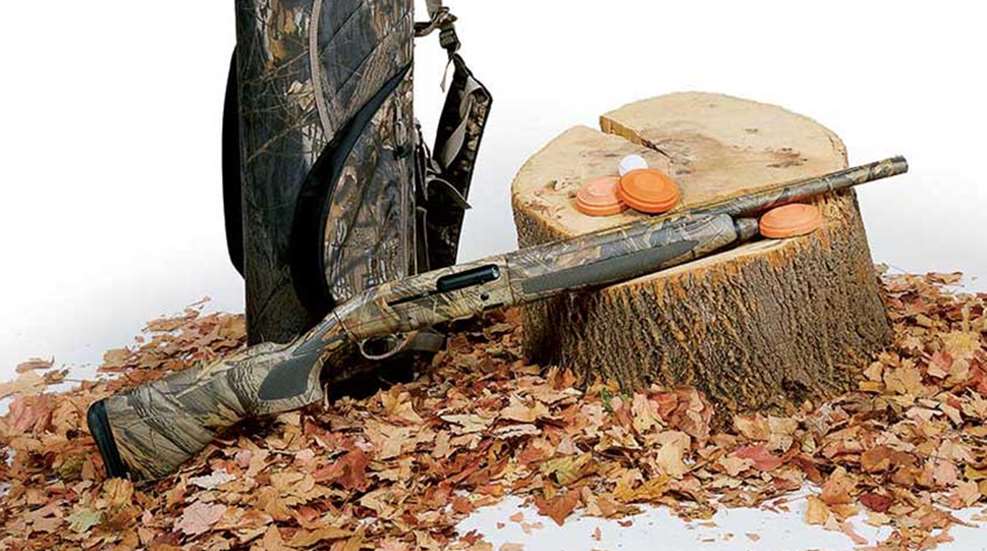
This article, "A Hunter's Approach to Trap & Skeet," appeared originally in the September 2003 issue of American Rifleman. To subscribe to the magazine, visit the NRA membership page here and select American Rifleman as your member magazine.
Want to hit more birds in the fall? Take up trap and skeet. Hunters who spurn clay target practice tell you: “Real birds don’t flush when you yell pull.” They’re missing the point.
Baseball sluggers don’t practice by hitting in games; they go to the batting cage to groove their swing. Same thing with shotgunning: Hone your fundamentals at the gun club in the summer, and you’ll hit birds through force of habit in the fall.
Shortly after I took up trapshooting, I remember distinctly watching a rooster flush and hearing a little voice of recognition in my head say “that’s just like the quartering bird from the fourth peg.” The gun moved to the right place all by itself and the bird fell.
Sporting clays gets the recognition it deserves as field practice; I’m here to stick up for trap and skeet. If sporting clays is “golf with a shotgun” then trap is the driving range and Skeet the putting green—practice fields where you can work on parts of your game under controlled conditions.
Between the two games, you’ll see every angle you’ll encounter in the field. You can shoot trap and skeet at night, under the lights. A couple of rounds of either game cost less than 50 sporting clays targets, and take much less time to shoot.
It’s fashionable to denounce trap and skeet as boring, rote exercises in perfection. Moreover, many people will tell you that trap and skeet have so evolved into ends unto themselves that they no longer have any value as wingshooting practice. You need only look at the specialized guns of trapshooters with their release triggers, 34” barrels and high ribs, or the 9-lb., tubed over-unders favored by winning skeet shooters to believe this is true.
I’ve hunted with serious trap and skeet competitors, and I’m here to tell you they can hit feathered birds as well as they bust clays. Besides, we don’t have to play the games the way the experts do if all we’re concerned with is hitting more birds in the fall. Get your field gun out of the closet, take a hunter’s approach to trap and skeet, and I promise you’ll be a better wingshot for it.
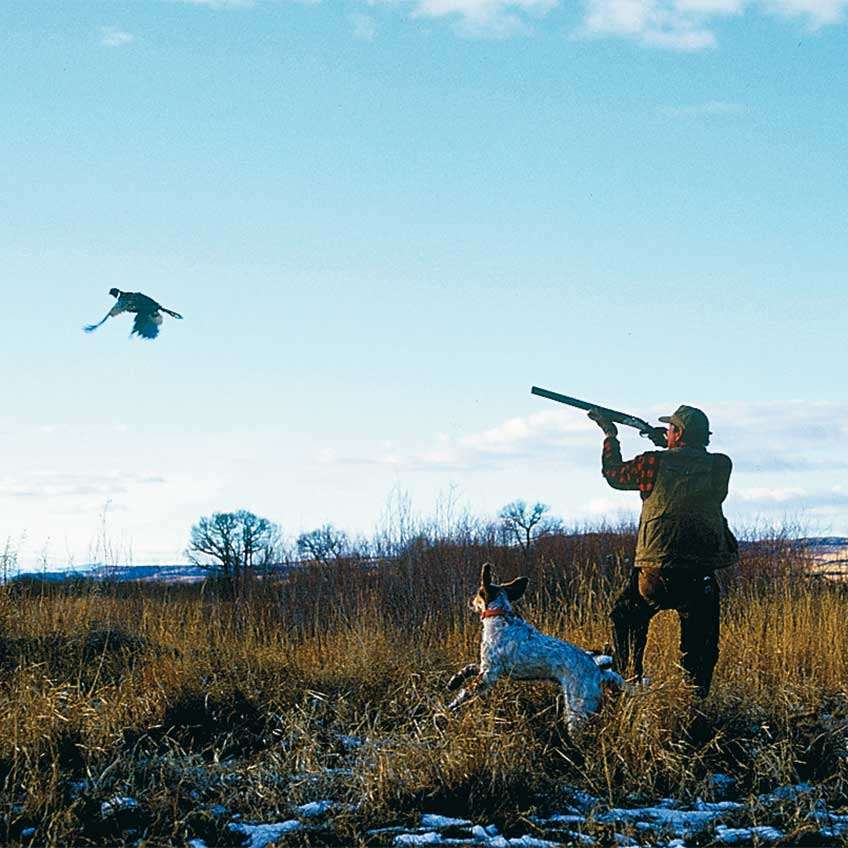
Getting Started
The first trip to the gun club intimidates a lot of hunters; the shooters all seem to own guns that cost as much as your car and approach their games with humorless poker-faces. In fact, most of them are happy to see a newcomer. They’ll offer free advice and tips. A few will even know what they’re talking about.
Point is, don’t be put off by first impressions. The regulars will be more comfortable with you, however, if you’re familiar with the basic rules of gun club safety. All gun clubs require eye and ear protection. Most enforce the rule strictly, but even if they don’t, wear ear plugs and shot-proof glasses.
Cheap foam earplugs actually offer some of the very best hearing protection available. Clubs sell them on site so there’s no excuse to shoot without them. Your glasses needn’t be expensive but they should be tough. Shards of incoming clay targets on the skeet field can hit hard enough to draw blood. I saw one friend of mine who still insists on shooting without glasses (he doesn’t wear his seatbelt, either) get cut just below his dominant eye by a piece of a low house one target.
As for ammunition, clubs prohibit any shot larger than 7 1/2 for safety reasons. Hunters are the worst offenders to this rule, bringing odds and ends left over from the season to burn up at clays. Don’t do it. The only time I’ve ever been shot was at my club where the last station on the sporting clays course faced a skeet field a few hundred yards away. It was far enough to be out of range of small shot, but one day several of us were spattered with the No. 5s or 6s someone had brought to the club. They didn’t hit hard enough to break skin, but they stung.
Never load your gun until you’re about to shoot and only load one shell at a time for American trap, one or two for skeet, depending on whether you’re shooting single or double targets. As you walk from station to station, your gun should be unloaded with the action open. One oddity you’ll notice on trap and skeet fields is shooters resting the muzzles of their guns on their toes. You can even buy little pads made for just that purpose. It’s allowable at trap and skeet, but not a safe habit to get into.
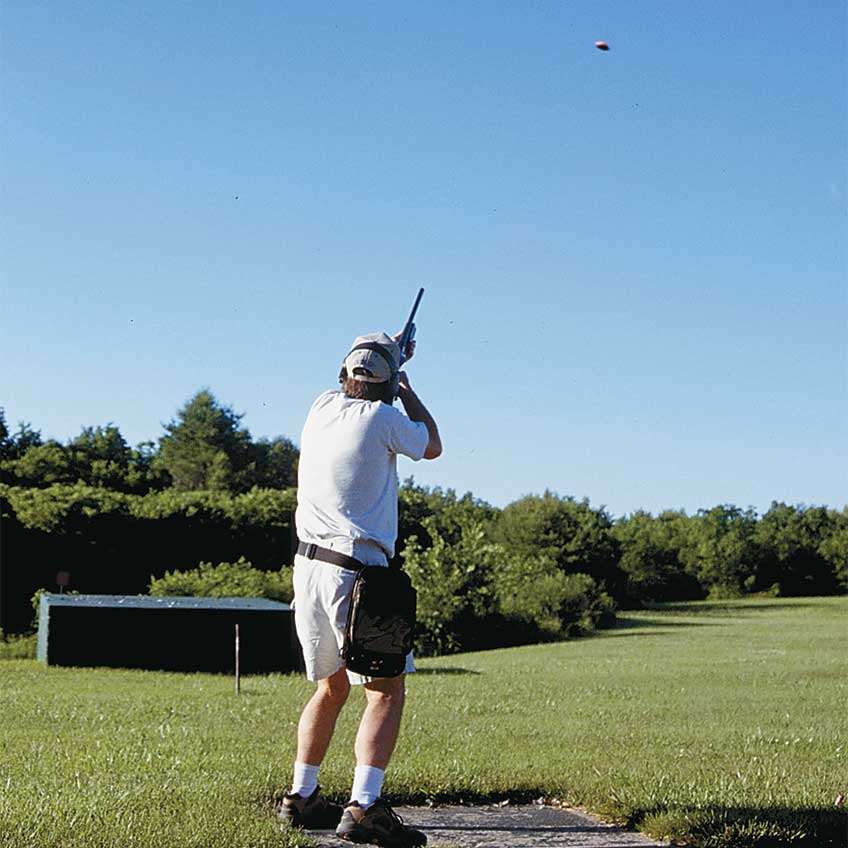
Trap Shooting
Trap, with its straightaway, quartering and angled targets makes excellent practice for upland shooting. The game demands precise gun pointing while punishing head-lifters mercilessly. A round of trap consists of 25 shots. You stand on one of five stations arranged in an arc 16 yds. behind the traphouse, which throws outgoing birds on your call.
However, the trap oscillates back and forth, so you never know which angle you’ll have to shoot. You take five shots in turn from each station. On the puller’s command of “walk” you rotate to the next pad, with your gun pointed in a safe direction and the action open.
In trap, it’s important to keep quiet and try to keep the squad’s rhythm intact. Wait to pick up your empties after the round; don’t yell “nice shot!” or “rats!” or whatever. It doesn’t mean trap is no fun, just that you shoot it as part of a squad and you’re expected to behave in a way that keeps the round moving. You’ll learn soon that a good squad falls into a rhythm that actually helps everyone break more targets.
Trap allows you to start with a premounted gun. The initial hold point—where you point the gun in relation to the house—is very important. Experiment until you find a hold point that works for you. Many shooters like to hold their guns almost parallel to the ground, pointing a few feet over the house; others will point right at the roof.
Likewise, some shooters hold on the center of the house from all five pegs, others will hedge, pointing their gun at the left corner of the house for instance, when they stand on the first post in order to get a little better jump on the hard left angled target. I shoot best when I’ve got the gun pointed over the middle of the house and fairly low. That way, I move the muzzle along the target’s path, swing through it, and shoot just as I would in the field.
Call for the target, then make sure your eyes go to the bird and read its angle before you move the gun. Initially the hard-angled targets from posts one and five will give you the most trouble. Actually, they’re not that difficult; just swing in front of them and shoot.
Eventually you’ll discover the truism, “trapshooters fear the angles and miss the straightaways.” Straightaway targets are deceptively difficult and easy to shoot over or under, as are the gentle quartering angles you misread as straightaways. While you will hear that people miss under quickly rising trap targets, beginners often shoot over them, waiting too long and shooting over the birds as they level out and begin to fall.
Dedicated trap guns have long barrels, tight chokes and raised combs that enable the shooter to “float” the target, that is, to see it over the top of the barrel. That said, your duck gun should work just fine.
You can buy pads that raise a gun’s comb to make it closer to trap gun dimensions but they’re not really necessary; just blot the bird out with the barrel and shoot it exactly as you would in the field. If you do add height to your gun’s comb, remove it for your last few practice sessions before hunting seasons open. If you’re up for a challenge, shoot your last few rounds of the year from the low gun position.
A modified, improved-modified or full choke will give you tight enough patterns to solidly smack targets from the 16-yd. line. If you move back to the handicap distances—up to 27 yds. behind the house—shoot a full. As for loads, No. 7 1/2 and No. 8 shot work best, with 7 1/2s outperforming the smaller pellets at longer ranges.
Do yourself a favor and shoot light loads. For some reason you feel recoil more on the trap field than anywhere else. An ounce of shot is sufficient to crush 16-yd. targets, and if you’re a reloader, you might try whipping up some 7/8-oz. loads. No one shoots well while they’re getting beat up, and if you develop a flinch at the gun club that carries over to your field shooting, you’ve defeated the whole point of practicing.
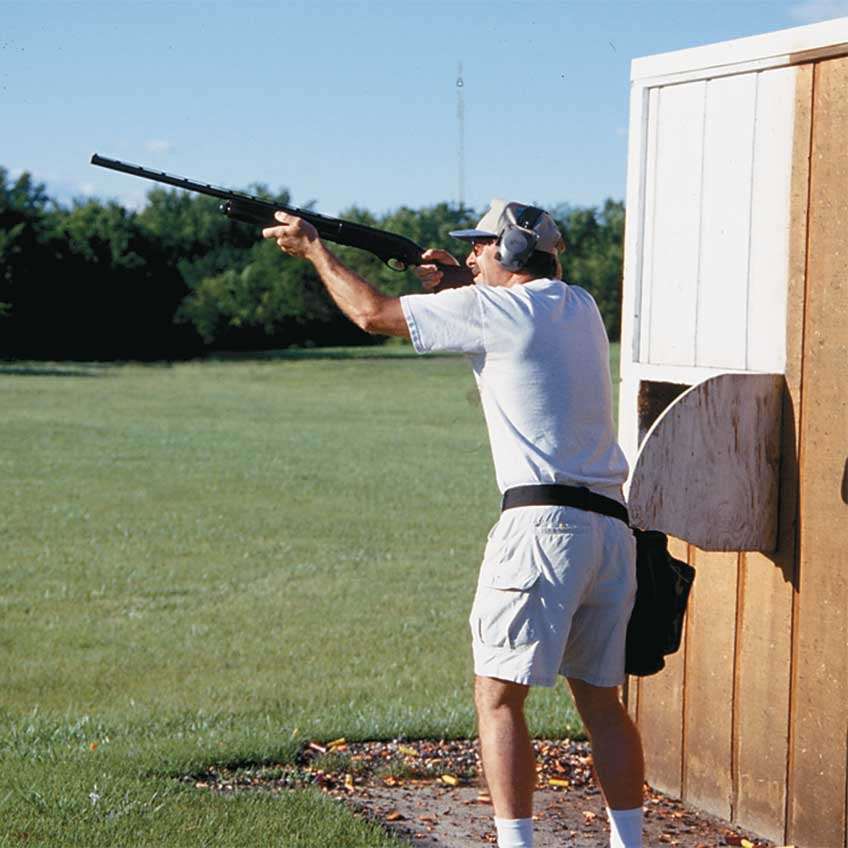
Skeet Shooting
Although I enjoy trap and recognize its benefits for bird hunting, I spend most of my time on the skeet field these days. Skeet presents every angle you’ll see in the field; it’s kind of a condensed version of sporting clays. You shoot going-away birds, crossers and incomers. The game lends itself very well to shooting with an unmounted gun. And, it’s a little more sociable than trap, since you spend more time standing around waiting for your turn to shoot.
As with trap, you shoot a round of 25 targets. A skeet field has eight stations, seven of them arranged in an arc running from the high house to the low house. The last station, eight, is right out in the middle of the field. You shoot first a high house then a low house target at each station, and single and double targets at stations one, two, six and seven.
To make a round of 25, you repeat your first miss, called your “option” or, if you break them all, you shoot the last target twice. Typically, most hunters do well at one, two, six and seven in their initial rounds, then struggle with the crossing targets which require some pretty long leads.
What makes it worse is that you often find yourself squadded with an experienced shooter who, while genuinely trying to be helpful, says “Shoot three-and-a-half feet in front of this one.” Everyone sees lead differently; 3 1/2 ft. for one shooter might be 1 ft. for another, 7 ft. for someone else. Besides, if you try to measure leads precisely, you’ll slow the gun and miss for sure.
The easiest way for me to break crossing targets (and a method that works in the field, too) is to mount ahead of the bird, swing until I see a good-sized gap between the target and the blur of my muzzle, let fly and follow through. When people ask me how far I was in front of the target, I honestly can’t tell them. What I do know is that if you mount ahead of the target you never have to scramble to catch up to it.
Skeet doubles really aren’t that difficult. Never mind that real gamebirds rarely fly right at one another the way birds launched simultaneously from the high and low houses do; doubles are fun. They’re also excellent for keeping your pumping stroke sharp if you shoot a slide action. Always shoot the outgoing target first. Keep your focus on the first target until you see it break, then look for the second bird. You should find it just off your left shoulder on stations one and two, off the right shoulder on six and seven.
Station eight, in the middle of the field, challenges beginners, but actually high and low eight are two of the easiest birds on the field. At first it seems like you have no time to react to the birds that zip almost directly over your head. However, if you hold your gun on the bottom outside corner of the opening in the house you’ll get a good view of the bird as it emerges. Then, just keep your eye on the target, swing and turn it into an inkblot.
As with trap, experiment with your hold point. In skeet, you always know exactly where the target will fly: directly over the crossing stake halfway between the two houses. Set up for the target by facing just past where you plan to break it and then wind your body back toward the house. Start too close to the house, and the target will be a blur streaking past your muzzle. Start too far out, and you won’t generate the gun speed you need. Once you find a hold that works for you at a particular station, memorize it.
You can shoot just about any gun you want at skeet as long as it holds two shells. Even though skeet is a close-range game, I shoot it best with a long-barreled gun that helps smooth my swing and add some follow-through. A cylinder, skeet or improved-cylinder choke is a definite asset as you’ll shoot some birds a few yards off the muzzle.
A 12, 16, 20 or 28 ga. has all the pattern density you need to break targets with authority. Many competitors, in fact, carry a higher average with the light-kicking 28 than with the larger 20 ga. Only shoot the .410 if you need a dose of humility. Three-quarters of an ounce to an ounce of No. 9s make the best Skeet loads. No. 8 1/2s are fine, and 8s will do in a pinch.
Skeet is great for shooting with a low (unmounted) gun. To get the best practice for hunting, don’t call for the target, snap the gun to your shoulder and start swinging. Instead, yell “pull,” then wait to move the gun until the target emerges and your eyes lock onto it. Swing the muzzle along the line of flight as you bring the stock to your face, and shoot as the gun hits your shoulder.
As with trap, you’ll often find yourself shooting skeet with experts who never miss while you flail away. Don’t compare yourself to them; they shoot thousands, even tens of thousands of shells a year, and they’ve “run 'em” many, many times. You, on the other hand, are there to become a better field shot.
Shoot with an unmounted gun if you want and don’t even look at the scorecard if it depresses you. Me, I like keeping score, if only as a yardstick for improvement. As I spend more time at the gun club, I find myself setting higher standards for my target and field shooting both. I expect to hit, not miss, when I pull the trigger.
Shooting trap and skeet have made me a better shot, and they’ve changed my attitude about hitting and missing. As a trapshooting great told me in an interview once: “If we both go quail hunting and we each kill four birds with six shots you’ll think, ‘I did pretty well.’ I’ll think, I made two bad shots.’”
Late in October, the once-a-year shooters show up at my gun club for their annual trap and skeet tune-up before pheasant and waterfowl seasons open. That’s too little, too late. Start shooting three or four rounds of skeet or trap a week now, and you’ll see real improvement when hunting season opens. If you’re not careful, you’ll find you’ve got a new hobby, too.













